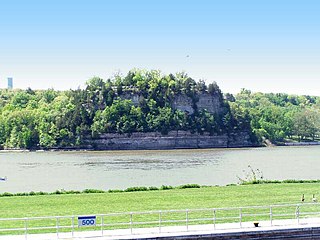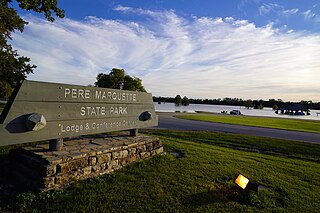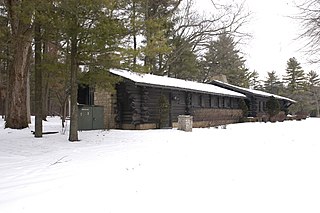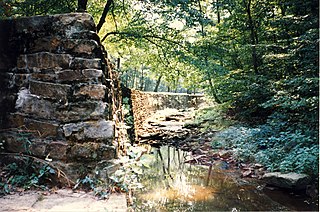History
The Illinois State Park system grew slowly at first. Fort Massac was the state's first park, in 1903, after that additions were sporadic, Starved Rock State Park was added in 1911 and remained, by far, the largest of Illinois' State Parks until the 1930s. In 1917 Illinois Governor Frank Lowden instituted major reforms in government which gave the governor direct control of state departments through a director who sat on a cabinet. Though many of the 1917 reforms, including one that authorized a governor-appointed Board of State Park Advisors, were not instituted until later a 1925 state law helped the State Park system grow.
The 1925 state law, which was later amended in 1931, gave the director of the Illinois Department of Public Works jurisdiction over the state parks. The Public Works position was one of Lowden's 1917 reforms that had already gone into effect. The law also mandated a system of state park's, [1] under the Illinois Department of Conservation, later renamed the Illinois Department of Natural Resources. [5] Per the 1925 mandate three of the parks included in the Multiple Property Submission became state parks in 1927, Black Hawk State Historic Site, Giant City State Park and White Pines Forest State Park. White Pines nearly became a state park in 1903, along with Fort Massac, but the $30,000 appropriation for its purchase was subject to a veto by Governor Richard Yates. Pere Marquette State Park was not acquired until May 1932. Known then as Piasa Bluff State Park, the 1,511-acre (611 ha) park was the largest in Illinois at the time.
In 1933 the state park system's development picked up. Under the governorship of Henry Horner the lodge projects at the state parks began. This was thanks in large part to the increase in federal funds thanks to the New Deal and the appointment of Robert Kingery as director of the Public Works Department. Kingery had guided the State Park Board of Advisors through the development of a preservation beginning in 1930. The need for the lodges had been set forth in that 1932 plan that Kingery had helped adopt.

Starved Rock State Park is a state park in the U.S. state of Illinois, characterized by the many canyons within its 2,630 acres (1,064 ha). Located just southeast of the village of Utica, in Deer Park Township, LaSalle County, Illinois, along the south bank of the Illinois River, the park hosts over two million visitors annually, the most for any Illinois state park.

This is a list of properties and districts in Illinois that are on the National Register of Historic Places. There are over 1,800 in total. Of these, 85 are National Historic Landmarks. There are listings in all of the state's 102 counties.

Fort Massac was a French colonial and early National-era fort on the Ohio River in Massac County, Illinois, United States.
The Illinois Historic Preservation Division, formerly Illinois Historic Preservation Agency, is a governmental agency of the U.S. state of Illinois, and is a division of the Illinois Department of Natural Resources. It is tasked with the duty of maintaining State-owned historic sites, and maximizing their educational and recreational value to visitors or on-line users. In addition, it manages the process for applications within the state for additions to the National Register of Historic Places.

Pere Marquette State Park is an 8,050-acre (3,260 ha) protected area in southwestern Jersey County, Illinois, United States. It is located near the city of Grafton, Illinois, at the confluence of the Mississippi River and the Illinois River. The park is located on Illinois Route 100, which at this location is also part of both the Great River Road and the Meeting of the Great Rivers Scenic Byway. The park is operated and maintained by the Illinois Department of Natural Resources, and is Illinois' largest state park in area. The park is also part of the Confluence Greenway and is at the northwestern end of the 21.5-mile (34.6 km) Sam Vadalabene Bike Trail.

The Peoria Marriott Pere Marquette, is a historic 14-story hotel in downtown Peoria, Illinois, United States. Built in 1926, the building is Peoria's only surviving example of an upscale 1920s hotel. It was listed on the National Register of Historic Places in 1982.

White Pines Forest State Park, more commonly referred to as White Pines State Park, is an Illinois state park in Ogle County, Illinois. It is located near the communities of Polo, Mount Morris and Oregon. The 385-acre (156 ha) park contains the southernmost remaining stand of native white pine trees in the state of Illinois, and that area, 43 acres (17 ha), was designated an Illinois Nature Preserve in 2001.

The White Pines State Park Lodge and Cabins are located in rural Ogle County, Illinois near the village of Mount Morris. They were added to the National Register of Historic Places in 1985. The Cabins are one of two Historic Places found in or near Mount Morris, the other is the Samuel M. Hitt House. The Lodge and Cabins are part of a National Register Multiple Property Submission, they were submitted with several other state park lodges, all designed by Joseph F. Booton.

Giant City State Park is an Illinois state park on 4,000 acres (1,619 ha) in Jackson and Union Counties, Illinois, United States. Illinois acquired more than 1,100 acres (450 ha) in 1927, and dedicated the park as Giant City State Park. A lodge and visitor center welcome state park guests.

Lowden State Park is an Illinois state park on 207 acres (84 ha) in Ogle County, Illinois, United States. The park was named after Governor Frank Orren Lowden. Governor Lowden had served Illinois during World War I. Lowden State Park is home to the Black Hawk Statue, by artist Lorado Taft. Lowden State Park was closed to the public due to budget cuts from November 30, 2008 until February 26, 2009.

Westmoreland State Park lies within Westmoreland County, Virginia. The park extends about one and a half miles along the Potomac River. The park covers 1,321 acres. The park's Horsehead Cliffs provide visitors with a panoramic view of the Potomac River. The park offers hiking, camping, cabins, fishing, boating and swimming.

The Black Moshannon State Park Historic Districts are three separate historic districts on the National Register of Historic Places (NRHP) at Black Moshannon State Park in Rush Township, Centre County, Pennsylvania in the United States. The structures in the historic districts were constructed in the 1930s during the Great Depression by the Civilian Conservation Corps (CCC). The three districts are: the Beach and Day Use District, with 18 contributing structures, including 11 different picnic pavilions, concession building, bathhouse, museum, and four open pit latrines; the Family Cabin District with 16 contributing properties, including 13 cabins, one lodge and two latrines; and the Maintenance District with four contributing properties, including a storage building, three-bay garage, gas pump house, and ranger's residence.

Copper Falls State Park is a 3,068-acre (1,242 ha) state park in Wisconsin. The park contains a section of the Bad River and its tributary the Tylers Forks, which flow through a gorge and drop over several waterfalls. Old Copper Culture Indians and later European settlers mined copper in the area. The state park was created in 1929 and amenities were developed by the Civilian Conservation Corps and the Works Progress Administration. In 2005 the park was listed on the National Register of Historic Places as a site with 10 contributing properties.

The Mason County Courthouse is in Mason County, Michigan. It is in the town of Ludington in Michigan's Lower Peninsula.

John Hauberg Museum of Native American Life is located in the Black Hawk Museum and Lodge at Black Hawk State Historic Site in Rock Island, Illinois, United States. The museum is in an historic building that was listed on the National Register of Historic Places as the in 1985. It is a part of the Illinois State Park Lodges and Cabins Thematic Resources.

Starved Rock Lock and Dam, also known as Lock and Dam No. 6, is a lock and dam facility managed by the U.S. Army Corps of Engineers along the Illinois River. It is part of the Illinois Waterway and was constructed between 1926 and 1933. The lock and dam was added to the National Register of Historic Places as the Starved Rock Lock and Dam Historic District in 2004.

Granot Loma is an estate located on County Road 550 north of Marquette, Michigan, constructed in the tradition of the Great Camps of the Adirondacks in the late 19th and early 20th centuries. It was listed on the National Register of Historic Places in 1991. It is said to be the "biggest log cabin in the world" and the most expensive residence in Michigan.

Black Hawk Museum and Lodge is a historic building located in the Black Hawk State Historic Site in Rock Island, Illinois, United States. The lodge was listed on the National Register of Historic Places in 1985. It is a part of the Illinois State Park Lodges and Cabins Thematic Resources.
Joseph F. Booton (1897-1983) was an American architect.

The Brooks Lake Lodge, also known as the Brooks Lake Hotel and Diamond G Ranch, as well as the Two-Gwo-Tee Inn, is a recreational retreat in Fremont County, Wyoming near Dubois in the upper Wind River valley. The complex was built in 1922 to accommodate travelers coming to Yellowstone National Park on U.S. Route 287 from central Wyoming. The buildings are mainly of log construction with Craftsman style detailing.



















